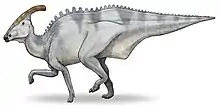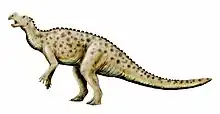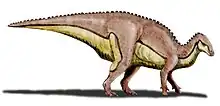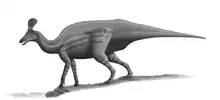| Charonosaurus Temporal range: Late Cretaceous, | |
|---|---|
 | |
| Reconstructed skull | |
| Scientific classification | |
| Domain: | Eukaryota |
| Kingdom: | Animalia |
| Phylum: | Chordata |
| Clade: | Dinosauria |
| Clade: | †Ornithischia |
| Clade: | †Ornithopoda |
| Family: | †Hadrosauridae |
| Subfamily: | †Lambeosaurinae |
| Tribe: | †Parasaurolophini |
| Genus: | †Charonosaurus Godefroit, Zan & Jin, 2000 |
| Species: | †C. jiayinensis |
| Binomial name | |
| †Charonosaurus jiayinensis Godefroit, Zan & Jin, 2000 | |
Charonosaurus (/kəˌroʊnəˈsɔːrəs/ kə-ROH-nə-SOR-əs; meaning "Charon's lizard") is a genus of dinosaur whose fossils were discovered by Godefroit, Zan & Jin in 2000, on the south bank of the Amur River, dividing China from Russia. It is monotypic, consisting of the species C. jiayinensis.
Description

Charonosaurus is a very large lambeosaurine hadrosaur, estimated around 10 metres (33 ft) in length and 5 metric tons (5.5 short tons) in body mass.[1][2] It is known from a partial skull (Holotype: CUST J-V1251-57 (Changchun University of Sciences and Technology, Changchun, Jilin Province, China) found in the Late Maastrichtian Yuliangze Formation, west of Jiayin village, Heilongjiang Province, northeastern China. Adult and juvenile hadrosaur remains discovered in the same area and formation likely represent the same taxon and supply information on most of the postcranial skeleton; the femur length was up to 1.35 m (4.5 ft). The partial skull resembles that of Parasaurolophus and probably had a similar long, backward-projecting hollow crest, indicated by the highly modified dorsal surface of the frontal bones. Charonosaurus is one of the largest hadrosaurs currently known from Asia and indicates that lambeosaurines survived until the very end of the Cretaceous (lambeosaurines are not known from the Late Maastrichtian in North America).[3]
History of Discovery
The remains of Charonosaurus come from large bonebeds (bone deposits) discovered since 1975, during excavations by several Chinese institutions around the city of Jiayin on the Amur River. The holotype material (specimen number CUST J-V1251-57), a fragmentary skull, was described as Charonosaurus jiayinensis by Pascal Godefroit, Shuqin Zan and Liyong Jin in 2000. The genus name is derived from Charon, the ferryman from Greek mythology who carried the dead across the dead river Acheron (or Styx), and the ancient Greek word sauros (lizard). The specific epithet jiayinensis refers to the type locality (site) Jiayin.[3]
Stratigraphically the finds are from the Yuliangze Formation. The first finds from this formation were recovered in the summers of 1916 and 1917 by excavations of the Russian Geological Committee. Among them are bones of hadrosaurids described by Anatoly Riabinin as Manchurosaurus amurensis. Furthermore, Riabinin assigned another find, a very fragmentary ischium, to hadrosaurids and named it Saurolophus krystofovici. Both names are nowadays considered as nomina dubia.[3]
Phylogeny
A cladistic analysis in 2000 by Pascal Godefroit, Shuqin Zan and Liyong Jin based on 33 skull, tooth, and postcranial features shows that Charonosaurus jiayinensis could be phylogenetically more closely related to Parasaurolophus than to any other lambeosaurine. Characteristics that cannot be directly determined on the available bones were not included in the analysis. Eolambia and Tsintaosaurus were also not included in the analysis because these taxa are in need of revision according to Godefroit et al.[3] The following phylogeny was conducted by Penélope Cruzado-Caballero et al. in 2013.[4]
| |||||||||||||||||||||||||||||||||||||||||||||||||||||||||||||||||||||||||||||||||||||||||||||||||
Taphonomy
In the Yuliangze Formation near the village of Jiayin, bone beds were discovered scattered over several tens of square meters, consisting mostly of bones of Charonosaurus jiayinensis.[3] These bone beds contain numerous skeletons of both young and adult animals. They are out of anatomical alignment and intermingled. Long bones are oriented in one direction and the vertebral arches, spinous processes and transverse protrusions of the vertebrae (the apophyses) are broken off. These taphonomic features indicate that the thanatocoenosis formed in a river or stream environment with relatively strong currents, causing dinosaur carcasses to be concentrated and piled up at a low point in the landscape at the time.[3]
The bone beds consist of about 90% lambeosaurine fossils. Bones of ankylosaurs, theropods, turtles, and crocodiles make up the remaining ten percent.[3] The bones of the lambeosaurines of Jiayin belong to only one species, Charonosaurus jiayinensis, and there is no evidence that it lived with any other species of lambeosaurine in this restricted area. The abundance of ejected teeth from carnivorous dinosaurs shows that carcasses of Charonosaurus were torn up and consumed by predators and scavengers and/or that Charonosaurus was killed by these predators on hunts along a river.[3]
Palaeoecology
Charonosaurus jiayinensis is only known from the site at Jiayin. The thanatocoenosis of the type locality of this species further consists of an unidentified hadrosaurine,[5] the lambeosaurine Amurosaurus, an unidentified ankylosaurian,[3] the tyrannosaurid Tarbosaurus bataar,[3] unidentified tortoises, turtles of the species Amuremys planicostata and unidentified crocodiles.[3] The Blagoveschensk thanatocoenosis (Udurchukan Formation, Tsagayan Group) contains, in addition to hadrosaurids, an unidentified titanosaur,[6] unidentified theropods,[7] unidentified turtles,[8] unidentified Nodosauridae,[8] and unidentified crocodiles.
See also
References
- ↑ Holtz, Thomas R. Jr. (2012) Dinosaurs: The Most Complete, Up-to-Date Encyclopedia for Dinosaur Lovers of All Ages, Winter 2011 Appendix.
- ↑ Paul, Gregory S. (2016). The Princeton Field Guide to Dinosaurs. Princeton University Press. p. 342. ISBN 978-1-78684-190-2. OCLC 985402380.
- 1 2 3 4 5 6 7 8 9 10 11 Godefroit, Pascal; Shuqin Zan; Liyong Jin (2000). "Charonosaurus jiayinensis n. g., n. sp., a lambeosaurine dinosaur from the Late Maastrichtian of northeastern China" (PDF). Comptes Rendus de l'Académie des Sciences, Série IIA. 330 (12): 875–882. Bibcode:2000CRASE.330..875G. doi:10.1016/S1251-8050(00)00214-7.
- ↑ Cruzado-Caballero, P. L.; Canudo, J. I.; Moreno-Azanza, M.; Ruiz-Omeñaca, J. I. (2013). "New material and phylogenetic position of Arenysaurus ardevoli, a lambeosaurine dinosaur from the late Maastrichtian of Arén (northern Spain)". Journal of Vertebrate Paleontology. 33 (6): 1367–1384. doi:10.1080/02724634.2013.772061. S2CID 86453373.
- ↑ "Wu, W.-H., Godefroit, P., & Han, J.-X., 2010. A hadrosaurine dentary from Upper Cretaceous of Jiayin, Heilongjiang. Global Geology 29(1): 1-5
- ↑ Mannion, P.D., Upchurch, P., Barnes, R. N. and Mateus, O. (2013). Osteology of the Late Jurassic Portuguese sauropod dinosaur Lusotitan atalaiensis (Macronaria) and the evolutionary history of basal titanosauriforms. Zoological Journal of the Linnean Society 168:98-206, DOI:10.1111/zoj.12029
- ↑ Godefroit, P., Bolotsky, Y.L., and Van Itterbeeck, J. 2004b. The lambeosaurine dinosaur Amurosaurus riabinini, from the Maastrichtian of Far Eastern Russia. Acta Palaeontologica Polonica 49: 585–618.
- 1 2 Bolotsky, Y. L. and Godefroit, P. (2004). A new hadrosaurine dinosaur from the Late Cretaceous of Far Eastern Russia. Journal of Vertebrate Paleontology 24(2): 351–365.







